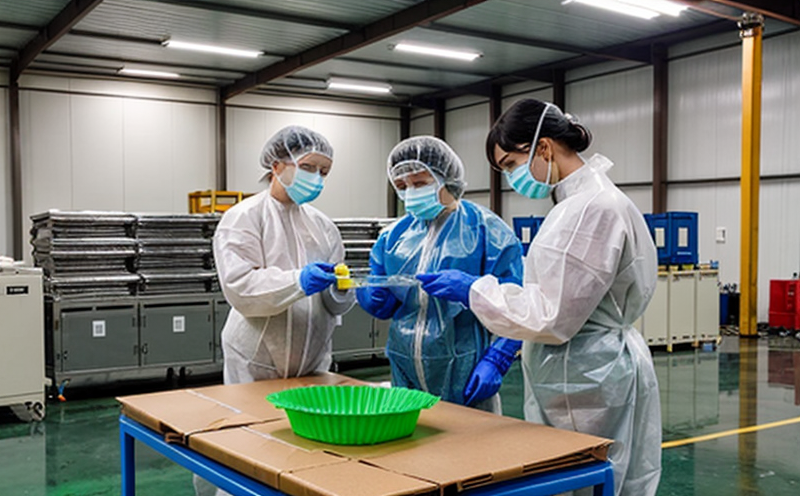ISO 180-2 Izod Impact Test on Rigid Containers
The ISO 180-2 Izod impact test is a standardized method used to assess the notched impact resistance of rigid containers made from plastic materials. This test is particularly crucial for industries that rely heavily on packaging solutions, ensuring that products meet safety and performance standards before reaching consumers.
Developed by the International Organization for Standardization (ISO), this standard provides precise protocols for measuring the energy absorbed during a notched impact on specimens cut from rigid plastic containers. The test is designed to simulate real-world conditions where materials might encounter sudden impacts, such as dropping or bumping into objects. By quantifying how much energy a container can absorb before fracturing, this method helps manufacturers optimize their designs and ensure product safety.
For quality managers and compliance officers, understanding the nuances of ISO 180-2 is essential for maintaining high standards in product development and manufacturing processes. The test involves several critical steps: specimen preparation, instrument calibration, impact testing, and data analysis. Proper execution ensures accurate results that can be used to make informed decisions about material selection and design improvements.
The Izod impact test plays a vital role in the research and development (R&D) phase of plastic packaging manufacturing. Engineers use this information to refine formulas and processes for creating stronger, more resilient containers. Additionally, procurement teams benefit from knowing the outcomes of these tests when selecting suppliers, ensuring that only materials meeting stringent criteria are used.
Understanding the test parameters is also beneficial for those involved in regulatory compliance. Compliance officers can leverage ISO 180-2 to ensure their products meet international standards, reducing the risk of non-compliance penalties and enhancing brand reputation. The test's precision makes it an indispensable tool in quality assurance programs across various sectors.
In summary, the ISO 180-2 Izod impact test on rigid containers is a cornerstone in ensuring the safety and integrity of plastic packaging products. Its role extends beyond mere testing; it serves as a guide for continuous improvement in material science and design engineering. By adhering to this standard, manufacturers can confidently produce high-quality products that meet global standards while contributing positively to environmental sustainability.
Industry Applications
| Industry | Description of Application |
|---|---|
| Aerospace | Evaluating the durability and integrity of containers used in aircraft interiors. |
| Automotive | Assessing the impact resistance of plastic parts used in car components. |
| Beverage | Determining the robustness of bottles and packaging for carbonated drinks. |
| Pharmaceuticals | Ensuring that drug containers can withstand potential impacts during distribution. |
| Consumer Goods | Evaluating the impact resistance of retail packaging to prevent damage in transit or storage. |
| Electronics | Testing the resilience of protective casings for electronic devices against accidental drops. |
| Food and Beverage | Assuring that containers used for transporting perishable goods can withstand handling stresses. |
The versatility of ISO 180-2 makes it applicable across multiple industries, ensuring that plastic packaging meets the rigorous demands set by each sector. By incorporating this test into their quality control processes, companies can enhance product safety and reliability.
International Acceptance and Recognition
The ISO 180-2 Izod impact test is widely recognized and accepted across the globe due to its comprehensive approach and consistent results. This international standard is adopted by numerous countries as part of their regulatory frameworks, ensuring uniformity in testing methodologies.
Many industry leaders and governments have incorporated ISO 180-2 into their quality assurance programs, recognizing it as a reliable means of assessing the impact resistance of rigid plastic containers. By adhering to this standard, companies can confidently demonstrate that their products meet global safety standards without needing additional local certifications.
The acceptance of ISO 180-2 is further bolstered by its alignment with other international standards such as ASTM D256 and EN 14342. This harmonization ensures that results are universally comparable, facilitating seamless trade between countries and industries.
For businesses operating in multiple regions or exporting their products internationally, compliance with ISO 180-2 is often a prerequisite for market access. Regulatory bodies around the world acknowledge this standard as proof of product safety and quality, making it an essential tool for global manufacturers.
Environmental and Sustainability Contributions
The ISO 180-2 Izod impact test not only contributes to the safety and integrity of plastic packaging but also plays a role in promoting environmental sustainability. By ensuring that containers are robust enough to withstand impacts, this test helps reduce waste associated with premature failure due to external forces.
Manufacturers who prioritize ISO 180-2 compliance can design products that are more durable and longer-lasting, reducing the need for frequent replacements or replacements altogether. This approach aligns with broader sustainability goals by minimizing resource consumption and landfill contributions.
The test's emphasis on material properties encourages innovation in sustainable packaging solutions. Engineers are motivated to develop materials that not only meet safety standards but also have lower environmental impacts throughout their lifecycle, from production to disposal.
Moreover, compliance with ISO 180-2 fosters responsible procurement practices by encouraging the selection of high-quality, durable materials that contribute positively to environmental sustainability. This holistic approach ensures that plastic packaging plays a constructive role in reducing overall environmental impact while maintaining essential safety and performance attributes.





